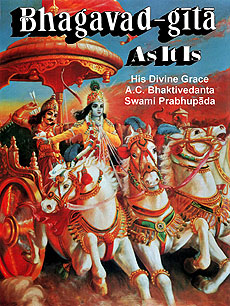Good Morning. HARE KRISHNA. Here's what the Bhagavad Gita, As It Is, mentions about black magic and those who practice it.
To this day we are in the middle of materialists demons who worship the material (Lower Energy of God) and they strive to have us follow them into Ghostly and Dark regions where they fulfill their desires of usurping The Supreme Godhead.
They are successful, too, because God has given all of us the freedom to explore. However, as humans, we are in the realm where our next trip can be back to the Godhead. If we realize that we are part of God and we in loving service can obtain his grace we are empowered to fulfill our desire be getting to know him personally.

Chapter 9: The Most Confidential Knowledge
TEXT 25
yanti deva-vrata devan
pitrn yanti pitr-vratah
bhutani yanti bhutejya
yanti mad-yajino 'pi mam
SYNONYMS
yanti—achieve; deva-vratah—worshipers of demigods; devan—to demigods; pitrn—to ancestors; yanti—go; pitr-vratah—worshipers of ancestors; bhutani—to ghosts and spirits; yanti—go; bhutejyah—worshipers of ghosts and spirits; yanti—go; mat—My; yajinah—devotees; api—also; mam—unto Me.
TRANSLATION
Those who worship the demigods will take birth among the demigods; those who worship ghosts and spirits will take birth among such beings; those who worship ancestors go to the ancestors; and those who worship Me will live with Me.
PURPORT
If anyone has any desire to go to the moon, the sun, or any other planet, one can attain the desired destination by following specific Vedic principles recommended for that purpose. These are vividly described in the fruitive activities portion of the Vedas, technically known as darsa-paurnamasi, which recommends a specific worship of demigods situated on different heavenly planets. Similarly, one can attain the pita planets by performing a specific yajna. Similarly, one can go to many ghostly planets and become a yaksa, raksa or pisaca. Pisaca worship is called "black arts" or "black magic." There are many men who practice this black art, and they think that it is spiritualism, but such activities are completely materialistic. Similarly, a pure devotee, who worships the Supreme Personality of Godhead only, achieves the planets of Vaikuntha and Krsnaloka without a doubt. It is very easy to understand through this important verse that if by simply worshiping the demigods one can achieve the heavenly planets, or by worshiping the pita achieve the pita planets, or by practicing the black arts achieve the ghostly planets, why can the pure devotee not achieve the planet of Krsna or Visnu? Unfortunately many people have no information of these sublime planets where Krsna and Visnu live, and because they do not know of them they fall down. Even the impersonalists fall down from the brahmajyoti. This Krsna consciousness movement is therefore distributing sublime information to the entire human society to the effect that by simply chanting the Hare Krsna mantra one can become perfect in this life and go back home, back to Godhead.
THE DISCIPLIC SUCCESSION
History of the Bhagavad-Gita